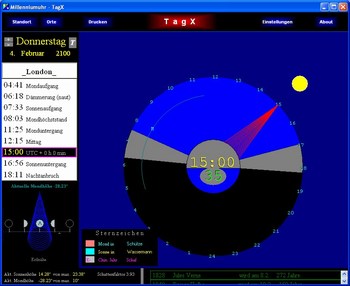Usage of the Millenniumuhr
Historians Sailors Astronomers
Hunters Foresters Gardeners
Fishermen Pilots and many more (Vacationers, Nature lovers, Hikers, Trips to the mountains,...)
Now some concrete examples of use will be shown.
Historians - Truth or Fiction ?
 On this ancient Babylonian wedge writing platelet there is - among others - noticed that there occurred a full moon in Babylonia on Saturday, the 7th of November in the year 7 B.C. at 07.33am. (Source: Kalender und Chronologie, Prof. Heinz Zemanek, 3rd Edition, Page 89).
On this ancient Babylonian wedge writing platelet there is - among others - noticed that there occurred a full moon in Babylonia on Saturday, the 7th of November in the year 7 B.C. at 07.33am. (Source: Kalender und Chronologie, Prof. Heinz Zemanek, 3rd Edition, Page 89). To verify this statement with the Millenniumuhr only the date (7.11.-7) and the time (7.33) have to be typed in. It is not necesary to choose the place Babylonia, since the phase of the moon is location-independent.
To verify this statement with the Millenniumuhr only the date (7.11.-7) and the time (7.33) have to be typed in. It is not necesary to choose the place Babylonia, since the phase of the moon is location-independent.The yellow arrow in the moongraphic indicates the phase of the moon (cp.: picture). On this date he points exactly at the full moon!
The result is non-ambiguous:
The statement on the wedge writing platelet is minutely correct!
Seamen, Fishermen, Astronomers, Hunters, Foresters, Gardeners, Pilots,... - bright or dark ?
Wherever one sojourns (in the mountains, by the sea), the times of the twilights are always quite precise!-whereas sun- and moonrises can often not be observed when they are not in sight on the horizon due to mountains, houses, or clouds.
Example : Twilight-levels in London on February, the 4th in the year 2100

Civil Twilight :
At what time it is bright enough (too dark) to read the papers?
Nautical Twilight :
Until what time can the horizon still be recognized resp. at what time will it be possible to see the horizon?